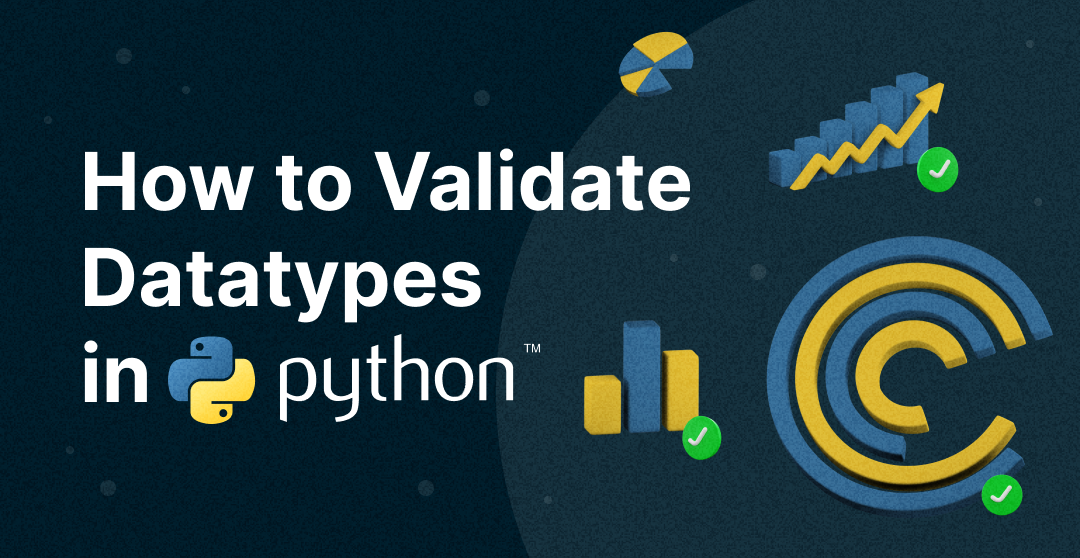How to Validate Datatypes in Python
 Christopher Garzon
Christopher Garzon
This article isn’t just about the ‘how’ — it’s an exploration of the best practices and methodologies seasoned data engineers employ to enforce data types rigorously. We’ll dissect the spectrum of techniques available in Python, from native type checking to leverage robust third-party libraries and distill these into actionable insights and patterns you can readily apply to your projects.
Stepping beyond mere syntax, we’ll delve into the realm of designing validation strategies that align with real-world data engineering scenarios — strategies that are proactive rather than reactive, preventing problems before they ever have a chance to manifest.
Techniques for Datatype Validation
When handling data in Python, validating datatypes is a process we weave into our workflow to avoid the domino effect of type-related errors. Our toolkit is rich with Python’s built-in capabilities and bolstered by third-party libraries that give us flexibility and power. Here’s a breakdown of some core techniques for datatype validation that are essential in the repertoire of any data engineer.
Type Checking with type() and isinstance():
One of the simplest ways to validate datatypes is using the type() function. However, it’s quite rigid as it doesn’t account for subtype polymorphism. That’s where isinstance() comes in, offering a more flexible approach that can check for class inheritance, which is particularly useful when working with custom classes or when type hierarchy matters.
Custom Validation Functions:
For complex data pipelines, we often build custom validation functions that encapsulate the logic for our specific data structures. These functions might combine type checks with additional logic to ensure the data conforms in type and value, format, or structure — like checking a string to be a valid date.
Third-Party Libraries:
When we move beyond Python’s native capabilities, we find robust libraries tailored for data validation like Pandas, Pydantic, and Voluptuous. These tools come with their own mechanisms for ensuring datatype integrity. For example, Pandas ensures columns of a DataFrame retain their datatype, while Pydantic validates data against a predefined schema with support for complex types and custom validation logic.
Practical Application:
In our data pipelines, we often validate data as it’s ingested from various sources — be it a CSV file where we need to ensure numeric columns aren’t inadvertently read as strings or an API call where we verify the data structure before processing.
Implementing Custom Validation Functions
Implementing custom validation functions in Python allows us to check and ensure data types align with our expectations throughout our data pipelines. These functions are critical when dealing with data ingestion, transformation, and loading (ETL) processes where the integrity of data is paramount.
Example of how to write custom validation functions:
Step 1: Define the Validation Logic
The first step is defining what constitutes valid data for your application. For instance, if you’re expecting a dictionary with specific key-value pairs where the values need to be of certain types, your validation logic should reflect this.
Step 2: Create the Validation Function
Next, you’ll want to encapsulate this logic in a function. This function takes the data as input and checks it against the expected format and types.
def validate_data_type(expected_type, data):
if not isinstance(data, expected_type):
raise ValueError(f"Expected data type {expected_type}, got {type(data)} instead.")
def validate_record(record):
required_fields = {
'name': str,
'age': int,
'email': str,
'is_active': bool,
}
for field, expected_type in required_fields.items():
if field not in record:
raise KeyError(f"Missing required field: {field}")
validate_data_type(expected_type, record[field])
# Add more complex checks if needed
if record['age'] <= 0:
raise ValueError("Age must be a positive integer")
# Assuming email validation function exists
if not is_valid_email(record['email']):
raise ValueError("Invalid email address")
return True
Step 3: Use the Function in Your Data Pipeline
With your validation function in place, you can call it whenever you process a new record.
try:
is_valid = validate_record(new_customer_record)
except (ValueError, KeyError) as e:
print(f"Data validation error: {e}")
Step 4: Make the Validation Function Reusable
To make this function reusable, you might parameterize it further, such as passing the required_fields as an argument or designing it to work with various data structures.
By incorporating these custom validation functions into your data pipelines, you establish a strong defensive programming practice that can significantly reduce the risk of type-related errors in your data processing applications.
Elevate your data engineering skills and learn how to implement custom validation functions to new heights with DE Academy’s comprehensive Python courses.
Python Libraries for Data Validation
Pandas for Data Validation:
Pandas is a cornerstone in the data engineer’s toolkit, primarily for data manipulation and analysis. It includes features for data validation, especially useful when working with tabular data in DataFrames.
For example, you can define a schema for a DataFrame to ensure that each column contains data of the expected type using the dtypes attribute. Here’s a brief snippet demonstrating this:
import pandas as pd
# Define expected dtypes
expected_dtypes = {
'Name': 'object',
'Age': 'int64',
'Email': 'object',
'IsActive': 'bool'
}
# Load data into DataFrame
df = pd.read_csv('data.csv')
# Validate dtypes
if not df.dtypes.to_dict() == expected_dtypes:
raise ValueError("Dataframe does not match expected dtypes")
Pydantic for Data Validation:
Pydantic is a type validation and settings management library that uses Python type annotations. It excels in creating data models with fields corresponding to your expected data types, automatically validating incoming data.
Pydantic to validate a data structure:
from pydantic import BaseModel, ValidationError, EmailStr
class User(BaseModel):
name: str
age: int
email: EmailStr
is_active: bool
# Validate data with Pydantic
try:
user = User(name='Jane Doe', age=30, email='jane.doe@example.com', is_active=True)
except ValidationError as e:
print(e.json())
Voluptuous for Data Validation:
Voluptuous, another Python data validation library, allows for the composition of validation schemas that are simple yet expressive. It is especially useful for validating JSON-like data, configuration settings, or form data in web applications.
A basic example of using Voluptuous is as follows:
from voluptuous import Schema, Required
schema = Schema({
Required('name'): str,
Required('age'): int,
Required('email'): str,
Required('is_active'): bool
})
# Use schema to validate data
try:
schema({
'name': 'John Doe',
'age': 28,
'email': 'john.doe@example.com',
'is_active': False
})
except Exception as e:
print(f"Validation error: {e}")
Each of these libraries offers a unique set of features that can simplify the process of data validation. Whether you need to enforce data types, ensure the presence of certain keys or fields, or check for more complex conditions, these tools can greatly reduce the effort required and help you maintain the integrity of your data pipelines.
Testing and Debugging Data Validation
Testing and debugging are integral to ensuring your data validation logic is foolproof. A robust suite of tests can catch errors before they infiltrate your pipelines, while systematic debugging can resolve unexpected behavior swiftly.
Writing Tests for Validation Logic:
Utilize pytest, a powerful testing framework, to create tests for your validation functions. Begin by crafting simple test cases that confirm expected behavior for correct data types and then move on to tests that feed incorrect types to ensure they’re rejected as expected.
Here’s an example of a basic test using pytest for a hypothetical validation function:
import pytest
from my_validation_module import validate_record
def test_validate_record_correct_data():
input_data = {'name': 'Jane Doe', 'age': 30, 'email': 'jane@example.com'}
assert validate_record(input_data) is True
def test_validate_record_incorrect_age_type():
input_data = {'name': 'Jane Doe', 'age': 'thirty', 'email': 'jane@example.com'}
with pytest.raises(TypeError):
validate_record(input_data)
Strategies for Debugging:
When it comes to debugging, especially in complex data pipelines, logging is your first line of defense. Implement detailed logging within your validation functions to capture the state of your data and any errors. Tools like Python’s built-in logging module can be configured to provide varying levels of detail depending on the environment (development vs. production).
When you encounter a type-related issue, isolate the problem by:
Using unit tests to verify individual components.
Applying Python’s debugger (pdb) to step through code execution and inspect variables at different stages.
Printing or logging type information at various points in the data pipeline to trace where a type mismatch occurs.
Remember to test not only the ‘happy path’ but also edge cases and failure modes. Consider type edge cases — such as empty strings or lists, which are technically the correct type but may not be valid in context.
Wrap Up
The field of data engineering is ever-evolving, and staying ahead requires continuous learning and adaptation. Whether you’re just starting or looking to deepen your expertise, DE Academy offers a wealth of coaching, courses, and community support to help you.
Start for free ans explore DE Academy’s offerings and take the next step in your data engineering career.
Subscribe to my newsletter
Read articles from Christopher Garzon directly inside your inbox. Subscribe to the newsletter, and don't miss out.
Written by

Christopher Garzon
Christopher Garzon
The goal of data engineer academy is to help people do two things. Learn the skills needed to be in data related roles and learn how to ace the interviews as well. We believe data related roles are in the early phases of their growth. And in addition to learning the skills, learning how to pass the interviews are just as important and our goal is to create clarity when it comes to both of those skillets.